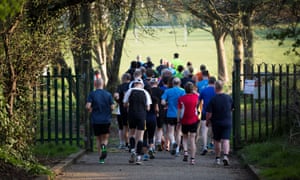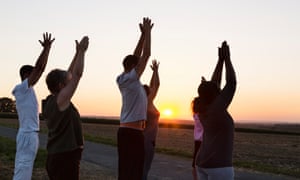
Should I eat breakfast before my morning workout?
You might think it wise to fuel up before a long run or cycle, but the latest research suggests you might be better off ignoring your gut instinct.
Professor Dylan Thompson, at the University of Bath, asked a group of overweight men to do two exercise sessions, first two hours after a 600-calorie breakfast and then, on another occasion, with an empty stomach. Tests identified differences in gene expression levels that signalled just how their bodies’ fat tissue responded differently depending on whether they had consumed food or not.
“Internal fat stores are broken down, to a greater degree, to sustain exercise following fasting,” says Prof Thompson. “Following breakfast, energy will come from the food that has just been consumed.”
So, if you want to reduce your risk of cardiovascular disease and type 2 diabetes, or just lose weight, you might want to skip breakfast before a workout. On the other hand, if you are trying to beat your personal best or competing, go for a high-energy meal two to three hours beforehand. People with type 1 diabetes are, however, advised to eat before exercise to avoid the risk of hypoglycaemia.

Is it best to work out with friends or alone?
If you have friends who spend most of their free time pounding the pavements or at the gym, they may well be chasing what some call the “runner’s high”. Scientists have shown that exercise can release natural painkillers in the brain and some say this evolved to reward the foraging efforts of our ancestors.
In 2010, the anthropologist Dr Emma Cohen, at Oxford University, showed the pain threshold of members of the Oxford rowing team was higher following group exercise than solo workouts. This suggested they were experiencing greater release of natural endorphins, mild opiates produced within the body to numb pain and generate pleasurable feelings. In 2015, Dr Cohen found that rugby players who went through synchronised warm-ups performed better in sprint tests than those who warmed up on their own.
There are other, non-physiological benefits of group exercise. “Research suggests that if people are meeting up with friends to exercise they are less likely to pull out,” says Dr Joe Costello, of the University of Portsmouth.
Should I stretch as part of my warm-up?
Many people stretch before running out on to a football pitch or tennis court, but sport scientists say there is no evidence that this reduces the risk of injury. What’s more, it can undermine performance, particularly in sports requiring bursts of power and sudden changes in direction.
Stretching reduces muscle stiffness, thereby slowing the speed at which they can transfer force and reducing the power of their contractions. One review of 104 previous studies by researchers at the University of Zagreb in Croatia found that pre-exercise static stretching, such as pushing against a wall or holding leg stretches, reduced muscle strength by 5.4%.
It is thought that regular stretching can increase flexibility, although it is not clear why. This is more important for gymnasts and dancers than for runners. Those recovering from injury, who may have a reduced range of movement, may also benefit.
“Stretching increases the range of motion in joints, but it has its biggest effect in muscles that are already warm and so is better done after exercise,” says Polly McGuigan, a lecturer in biomechanics at the University of Bath.
Which is better – running indoors or out?
Gym rats prefer the consistency and convenience of treadmills, while others head outdoors no matter the weather. But who is right?
Some say outside wind resistance uses more energy, but researchers found that setting a treadmill to a 1% gradient was enough to compensate for this effect. Running on varying terrain provides a workout for a greater range of muscles. Outdoor hazards such as air pollution, dog mess and security could tilt the balance back towards the gym, but treadmills put athletes at greater risk of injuries related to repetitive movements.
Studies show outdoor workouts generate greater feelings of well-being. Researchers at the University of Exeter who reviewed 11 previous studies in 2011found people felt more revitalised, energetic and positively engaged, and less tension, confusion, anger and depression, when they exercised outdoors. “There seem to be psychological benefits from exercising outdoors,” says Dr Costello. “However, when it’s dark and cold, it can be challenging to get out. So, as exercise physiologists, we’re slow to say one is better than the other.”

Is yoga really exercise?
The trend towards high-intensity workouts has reinforced the notion, held by some, that yoga doesn’t really count because most of its forms don’t make the heart pound. It does, however, lower blood pressure and the risk of heart disease. A review of 17 studies published in 2013 found yoga reduced blood pressure and therefore the risks of heart disease and stroke.
Another study found that overweight, middle-aged individuals who had done yoga for at least four of the previous 10 years had, on average, lost 5lbs. This compared to an average weight gain of 13.5lbs for those who hadn’t done yoga. The ancient Indian practice has been linked to hormonal changes that improve mood and boost sleep.
“During yoga, core muscles are required to generate more force than they ordinarily would, which causes an adaption response that strengthens those muscles,” says Dr McGuigan. “So yes, it is exercise. It is also complementary to other activities that require joint control, which is pretty much every sport.”

Is 30 minutes of high-intensity interval training (HIIT) once a week really enough?
HIIT involves alternating bouts of intense exercise of from 30 seconds to several minutes with recovery periods of one to five minutes. It has been touted as a way to help the time poor stay fit without having to slog through the recommended weekly exercise of 150 minutes.
Over 12 weeks, Canadian researchers asked sedentary men to do three weekly sessions of either three lots of 20-second all-out sprints interspersed with one-minute recovery periods, or 45 minutes of continuous, moderate-intensity cycling. Their study, published in 2016, found indicators of cardiovascular and metabolic health, such as VO2 max (our body’s maximum rate of oxygen use during exercise) and insulin sensitivity, improved by similar amounts in the two groups. A review of 16 previous studies involving more than 300 participants found that sprint interval training improves VO2 max by close to the same amount as moderate intensity endurance training.
Despite these positive signs, not everyone is convinced. “It seems that HIIT drives greater adaptation within skeletal muscles (those attached to bones by tendons),” says Prof Carsten Lundby, at University Hospital Copenhagen, “but prolonged, low-intensity endurance training provides greater cardiovascular adaptations, which, I’d argue, are of greater importance to your health. It can also be pretty unpleasant if you’re not used to training.”
Am I an exercise ‘non-responder’?
Anyone still harbouring illusions that life is fair need look no further than the gym to be disabused. The Canadian geneticist Claude Bouchard famously showed that some people who trained three times per week over 20 weeks could increase the maximum amount of oxygen they could use during exercise (VO2 max) by 50%, while others saw no improvement. He and others identified 11 genes that helped define 15% of people as “super-responders” – able to achieve big improvements in VO2 max through training – and 20% as “non-responders”.
However, research published in January shows that no one can play the non-responder card as an excuse. Prof Lundby showed that when volunteers did three or fewer 60-minute sessions on an exercise bike per week, some appeared not to benefit. However, when these supposed non-responders exercised three to five times per week, they all saw improvements. “If you train hard enough you will see an increase in VO2 max,” he says. And, even if you are a low responder, there are many benefits to working out that are unrelated to VO2 max.
Should I do weights or cardio? Or both?
Some athletes who train with weights avoid doing cardiovascular exercise for fear of losing their strengths gains. Older research suggested these fears could be justified. However, a meta-analysis, combining the results of 21 studies, published by a group at the University of Tampa, Florida, in 2012, showed a more nuanced picture. It found that those who focused on weight training gained more lower-body strength than those who did concurrent weights and running, but not weights and cycling.
There is growing recognition that moderate cardio training benefits metabolic health and recovery in ways that benefit even those focused on strength, and vice versa. “Endurance athletes are increasingly realising that there are benefits to doing some weight training, such as injury prevention,” says Dr Costello.’);
Between birth and around the age of 30, our muscles naturally grow larger and stronger, but from then on it’s all downhill, unless we take matters into our own hands. For most people, losses of muscle mass and strength are small until around the age of 50, but from that age inactive people can lose 1-2% of muscle mass per year. By the age of 60 it can be as much as 3% per year. What’s worse is that proportionally more fast-twitch muscle fibres – the ones needed for rapid movements – are lost as we age, compared to the slow twitch ones required for endurance.
The good news is that strength training can reduce these losses. “Some older people don’t like gyms,” says Dr McGuigan. “However, more and more studies are showing that exercises can easily be done at home to combat those losses.”
A forthcoming University of Bath study, for example, will show that older people saw improved muscle strength after four weeks of doing five simple one-minute exercises twice a day.
source;-theguardian